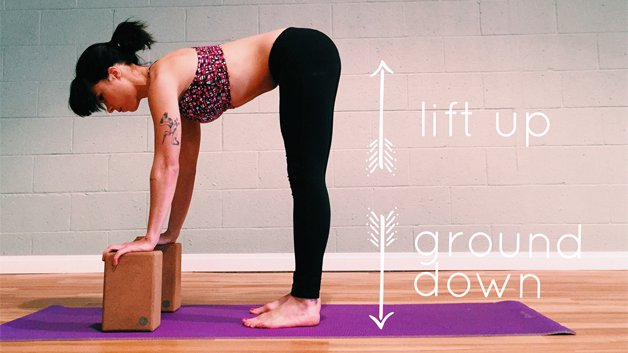Articles, Athletes, Hip, Uncategorized
Eccentric Hamstring Training: Fire Up Your Forward Fold
Here’s Part 2 on how to build eccentric strength in the hamstrings! Eccentric exercises are fantastic for injury prevention and boosting metabolism. They are even more effective at increasing strength and muscle fibre recruitment than traditional concentric work. Eccentric exercises are also far more potent for creating functional mobility than passive stretching, which, while useful for relieving acute tension, doesn’t actually create any permanent change in muscles’ length, or their ability to function in a lengthened position. If you’d like a refresher on what eccentric contractions are, and an asana example on how to get your hamstrings working eccentrically, take a look at Part 1 before proceeding.
Eccentric Stretch in Hip Flexion
Now that we’ve got the basics down and hopefully have a good sense of what an eccentric stretch feels like in real life, let’s find some ways to incorporate this action into a yoga practice. An opportunity for eccentric work presents itself whenever the hips are in flexion. In this instance, we’ll also want the legs to be as straight as possible. This causes significant lengthening in the hamstrings. We also want to avoid excessive rounding in the lumbar, which can allow very stiff students to inadvertently bypass the hamstring stretch altogether. While seated forward folds cover all these bases, they tend to be quite challenging to hold with good form for most athletes. So we’ll go with something a little more forgiving: Uttanasana, or standing forward bend.
Most people will benefit from having a couple of blocks handy for this. A mirror (or second pair of eyes) is also useful. Eccentric exercises are definitely on the more challenging end of the movement spectrum, so I wouldn’t recommend this for beginner-level yogis or athletes. But if you’re a teacher, or teaching advanced students, this is an interesting way to spice up a pose that’s traditionally associated with release and relaxation. And it’s challenging enough that three or so rounds should suffice!

Instructions:
- From standing, come into Uttanasana by hinging at the hip and draping your chest down towards the fronts of your thighs. Position the blocks under your hands at a height that lets you gently lengthen your spine forward, and takes any major effort out of the upper body. Look for a degree of hip flexion which produces a hamstring stretch that feels manageable and sustainable; things are about to get more intense, so resist the temptation to go for a deep stretch just yet.
- Your hips, knees and ankles should be vertically stacked up on top each other. Check the mirror, or have a friend correct your stance. Many people automatically move their hips back in space in Uttanasana to counterbalance the weight and forward movement of the upper body. This also instinctively avoids the much more demanding task of using the hamstrings to hold themselves in place instead.
- Maintain this alignment, and actively drive down into the floor with your heels.
- Maintain the grounding movement in the lower leg, then eccentrically contract the hamstrings: imagine that you’re attempting to lift the femurs up away from your knees and into your hip sockets. There will be no actual movement, but the sensation in the hamstrings should be something like a stretch and a contraction, happening simultaneously. Hold for as long as feels manageable.
- Carefully release and take a break in Uttanasana by letting the upper body relax and gently walking out the feet. If you’re teaching, cue a couple of deep inhales and exhales; most people focus so intently during this exercise that they forget to breathe. Take another round if you like, or try incorporating into sun salutations!
About the Author
 Jenni Tarma is a Los Angeles-based yoga teacher, writer, runner and CrossFitter. She specializes in making the yoga practice accessible and beneficial to athletes. She loves learning about anatomy and is currently studying for her 500hr certification with Yoga Medicine. You can find her on Facebook, or follow her on Instagram @jennitarma.
Jenni Tarma is a Los Angeles-based yoga teacher, writer, runner and CrossFitter. She specializes in making the yoga practice accessible and beneficial to athletes. She loves learning about anatomy and is currently studying for her 500hr certification with Yoga Medicine. You can find her on Facebook, or follow her on Instagram @jennitarma.












